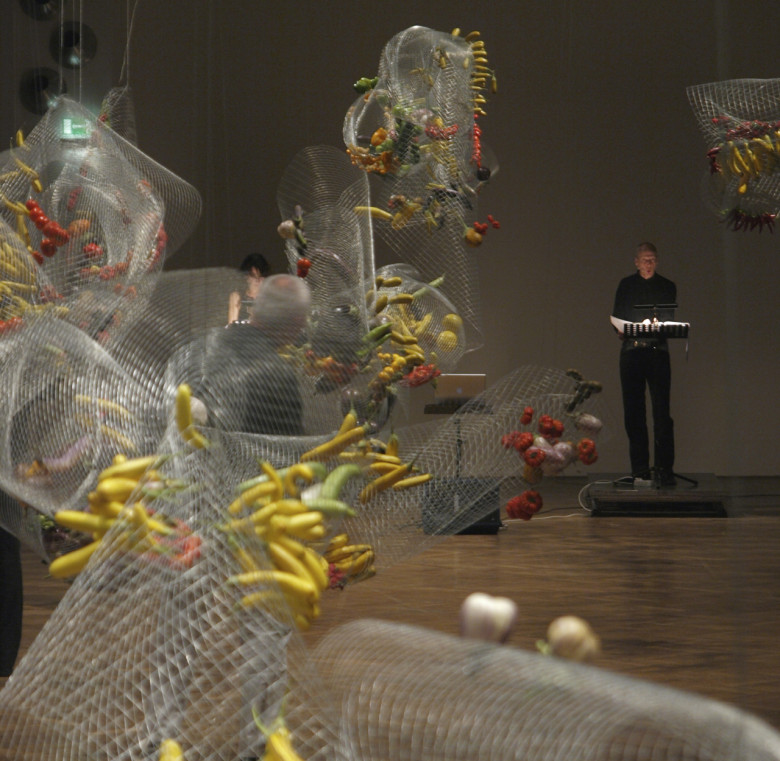@MAK Museum of Applied Art Vienna, Ausstellungshallen
Dienstag 29. September 18:00 bis 24:00
An art project conceived and produced for the MAK NITE 29.09.2009
Installation eines Chores und Premiere eines Konzeptstückes für Chor / Installation mit Nachtschattenfrüchten (Melanzani) / Kochkunst / Remix und Liveperformance elektronischer Musik
A cooperation of / featuring
Pia Palme, composition, concept and direction
Irene Pichlhöfer, spatial Ikebana installation
Electric Indigo, electronic music
Christina Bauer, sound design
Gartenbauschule Schönbrunn and DI Wolfgang Palme*, fruit production and horticulture
Wolfgang Reisinger and Hotelfachschule Modul, food design and cooking
Caroline Hofer, choir organisation
With texts by Oswald Egger and Sohpie Reyer (commissioned for the piece)
*nicht mit der Komponistin verwandt!
Performers
Annette Schönmüller, mezzo soprano solo / Johann Leutgeb, baritone solo
A mixed choir of 100 singers, assembled for the project through an open call
Pia Palme and Electric Indigo, live electronic remix
The piece was presented at the series MAK NIGHT at the MAK Museum of Applied Arts Vienna, combing cutting edge choral work and two soloists in a scenic setting of an installation, cooking and electronic music, lasting for 6 hours.
An installation of 700 kg of aubergines (80 heritage varieties) filling a complete hall was designed by Ikebana artist Irene Pichlhöfer. All fruits were produced and provided by the Gartenbauschule Schönbrunn celebrating the International Year of the Aubergines 2009. Director of the gardening project was DI Wolfgang Palme (who is not a relative of mine:-).
In Kooperation mit der Höheren Bundeslehr- und Forschungsanstalt für Gartenbau HBLFA Schönbrunn, Abteilung für Gemüsebau, im Rahmen des internationalen Jahresschwerpunktes Solanaceae/Nachtschattengewächse (Leitung: DI Wolfgang Palme).
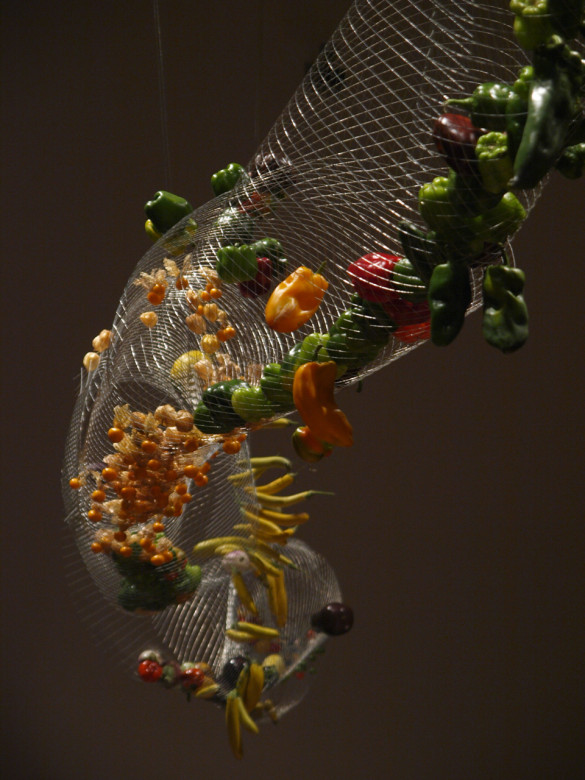
Thank you to the numerous helpers from the Gartenbauschule Schönbrunn, who delivered the fruit, to the Sogetsu Ikebana group Vienna who put together the installation, and to Wolfgang Reisinger’s cooking class from the Hotelfachschule Modul for the preparation and presentation of the food.


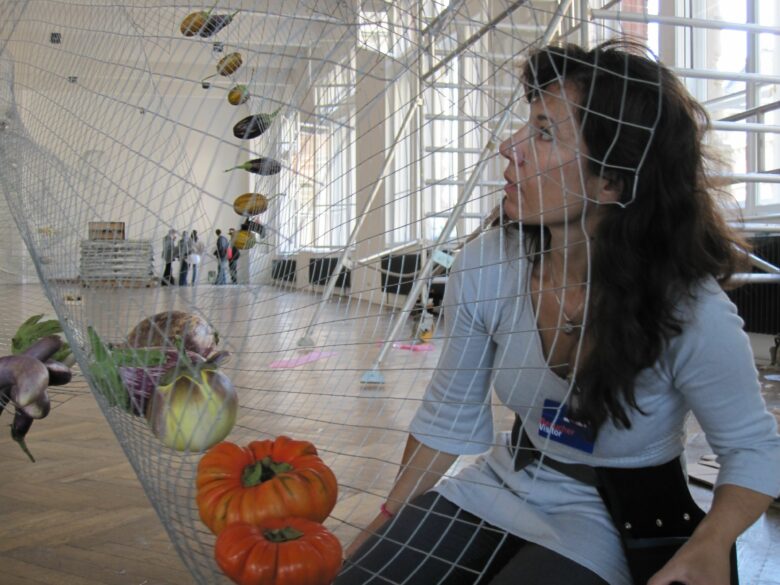
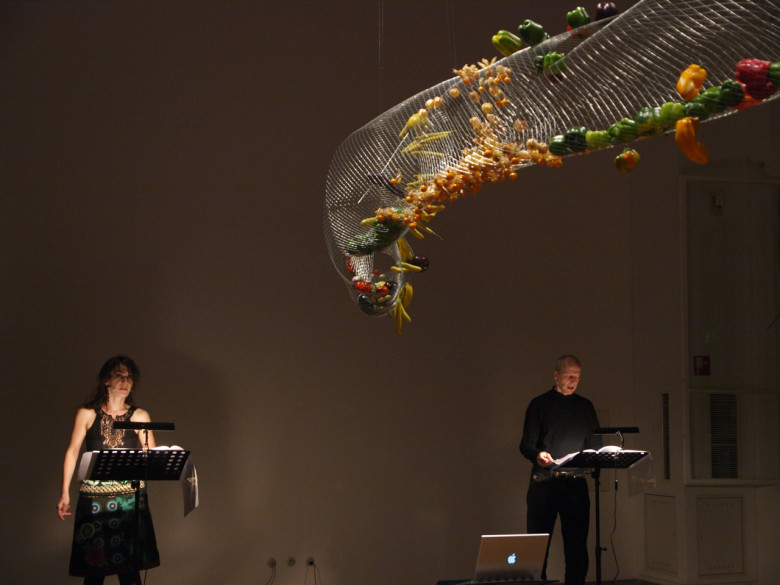

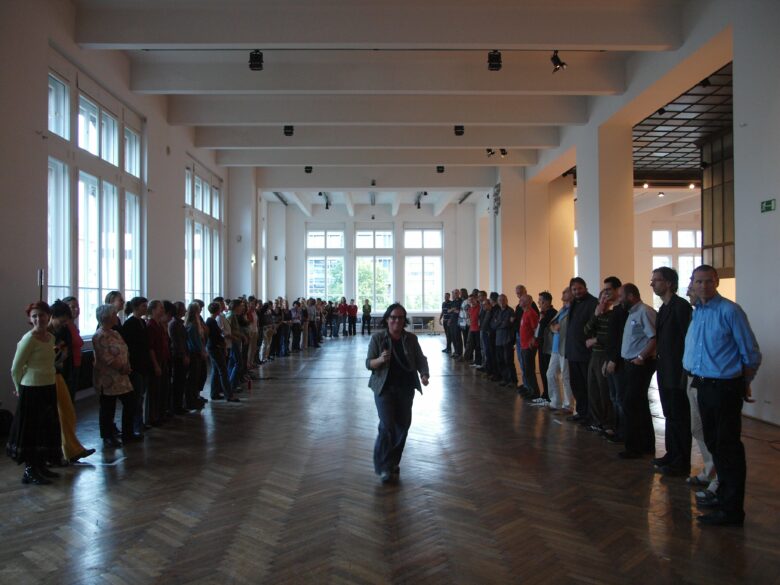
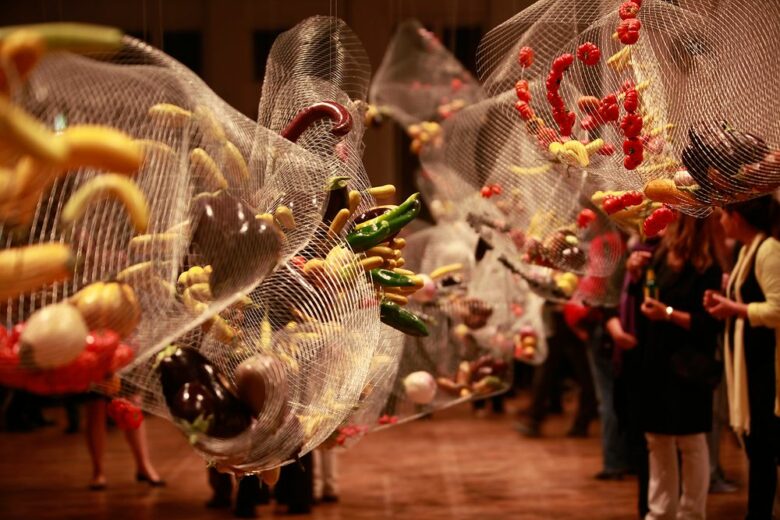
Details about the composition VARIETIES
The composition is a work for mezzo soprano and baritone solo, two lead singers (a male and a female voice) with headphones, a large mixed choir arranged in 2 lines/blocks (men, women), with texts by Sophie Reyer and Oswald Egger (commissioned for the piece). No conductor, the performers form a self-organising organism. Duration 30 minutes.
Technical requirements:
microphones for soloists (headset)
2 headphones (closed, high quality) for lead singers
long cables for transmission of solo-voices into headsets for lead singers.
Background, concept and directions for performance
The concept behind the composition VARIETIES is to represent a snapshot of the process of spreading, unfolding and propagating that starts from a central source of sound. I began with writing the duet for the mezzo soprano and baritone soloists. Their parts were composed with having the concept for the choir performing from audio-scores in mind.

The vocal duet is transmitted from the soloists to the lead singers of the choir via headphones. Then, the sound is passed on from one choir singer to the next one by ear, throughout the entire choir who is arranged in two lines. Conducting is redundant here—this was an important part of my concept, too.
Thus, singing happens by hearing. Synchronicity is more important than accuracy, so that flow of the piece is not interrupted. The instruction is: “Perform immediately what you hear. It is essential to perform on the spot whatever you assume to hear. If it is unclear, repeat or improvise. It is not possible to be 100% correct. Perform what you can hear from your neighbour, and not what you maybe hear from farther away along the line.”
The final piece as it is perceived by an audience is created through the performance of the two soloists and the vocal productions of the choir singers, who follow specific instructions.
My aim was to create a fuzzy, ambient-like vocal layer. I wanted an effect of delay and erosion. I come from electronic music and I aimed at a ‘biological’ delay and erosion.
Over thousands of years, gardeners have cultivated the fruit into many varieties. In a similar way, I compose a piece for a choir so that the voices can spread out into so many varieties, too. Fruit and voices appear in all kinds of colours and shapes.
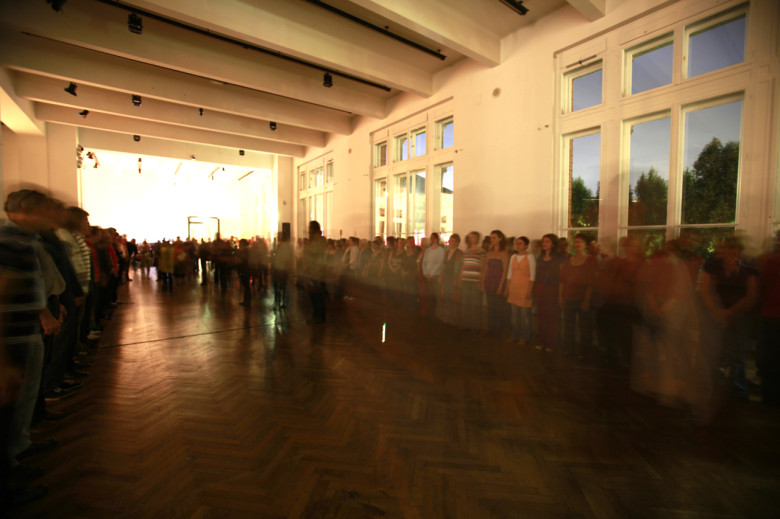
The arrangement of the choir in space is essential and should be carefully planned for the venue. The soloists should stand at a maximum distance from the choir—if possible, not even not in view of the choir, around a corner, for example.
About the piece
The choir consisted of 100 people, if possible the number of men and women should be somewhat equal. Both professional or trained singers were welcome, as well as any people who enjoy to sing and are somewhat skilled in using their voice.
For the choir lines, it works better to begin the line with more skilful singers and listeners and to place the untrained singers towards the end. The better trained the singers are, the better the concept works, actually. It is good to have practise time.
Blurring and delaying of sung parts will happen and are intentional.
Reproduction changes content.
Through the process of singing in this way, a floating and directional soundscape is created. The flow is moving in a direction away from the lead-singer. Parts are somewhat uncontrollably eroded and modulated, and also amplified and spatialised, as in electronic processing. Here, it happens ‘biologically’, through singers trying to perform as accurately as possible by ear.
If possible, the soloists can listen to the choir at least during the rehearsal, to be able to react to it: as their parts generate the piece, they should be aware of how the choir picks up their voices. Some choirs are more trained than others. The soloists are asked to perform like captains of an ocean liner: there is a latency when steering the choir with one’s performance.
A live recording of the piece was then remixed by Electric Indigo and myself. At the end, all fruits could be harvested by the audience. Nothing was left at the end.

About the texts
The texts for the piece were written by Oswald Egger and Sophie Reyer in coproduction. A verse by Egger was answered by a verse from Reyer, and so on. So the idea of propagation from a source, a first set of lines, was also followed here.
VARIETIES (2009)
Konzeptarbeit für zwei Solostimmen und großen gemischten Chor
Besetzung:
Mezzosopran Solo / Bariton Solo
2 LeadsängerInnen mit Kopfhörern
großer gemischter Chor, mind. 50 – 80 Personen, blockweise im Raum verteilt
(kein Dirigent)
Dauer 35 Minuten
Aufstellung dem Raum angepasst
Tontechnische Erfordernisse: Mikrofonierung der Solisten,
Übertragung dieser Solostimmen in guter Klangqualität auf 2 Kopfhörer
PA zur Verstärkung der Solostimmen
Texte: Sophie Reyer, Oswald Egger (für das Stück erarbeitet und ausgewählt)
Über das Stück
VARIETIES ist eine Momentaufnahme des Vorgangs der Ausbreitung, Vervielfältigung, Auffächerung von einem Punkt/einer Klangquelle aus. Die Komposition besteht aus einer Partitur für 2 SolistInnen, Mezzo und Bariton, und weiters eine Aufführungsanweisung für großen gemischten Chor mit zwei StimmführerInnen. Das Werk entsteht erst während der Aufführung zur Gänze, und zwar durch die mitwirkenden ChorsängerInnen. Die Chorklänge werden von den SängerInnen aus den zwei Solostimmen nach einem vorgegeben Verbreitungskonzept generiert.
Instruktionen für den Chor
Der Chor singt nach Gehör, es gibt keine Chorleitung. Das Stück kann einstudiert und geübt werden. Die Aufstellung ist wichtig und wird je nach Raum geplant. Die Solistin und der Solist sollen möglichst weit vom Chor entfernt stehen, idealerweise nicht im Sichtfeld der Chorsänger.
Durch die große Entfernung der SolistInnen und der ChorsängerInnen ergibt sich ein freier Raum als definierter Bewegungsraum für das Publikum. Die ZuhörerInnen bewegen sich hier ungezwungen, nach Belieben stehend oder gehend. Je nach Position ergibt sich ein völlig anderes Klangbild. Die Zuhörenden sind aktiv am Klanggeschehen beteiligt, indem sie ihre persönliche Klangmischung des Stückes herstellen: ein individueller Ambient (lat. ambire = spazieren) entsteht.
Für den Chor ist eine Mindestanzahl von ca. 12 Personen pro Stimme erforderlich, damit sich Klangflächen entfalten können. Ideal ist eine Größe von 30-40 Personen pro Stimme, und eine möglichst ausgewogene Zahl von Männern und Frauen.
Die Aufnahmen stammen von der Uraufführung im MAK; Fotos von Gabriela Koch und Armin Bardel.
Ein Remix entstand live aus Liveaufnahmen der Solostimmen, noch am Abend der UA, im MAK mit Electric Indigo.
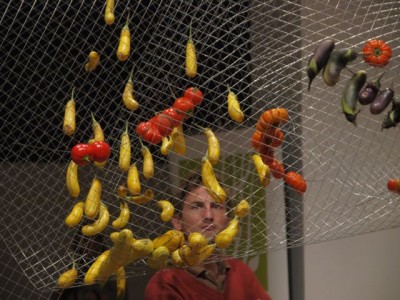
❏
